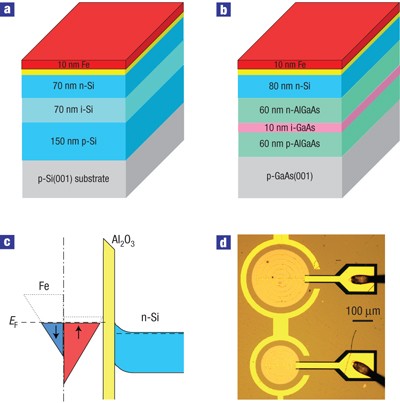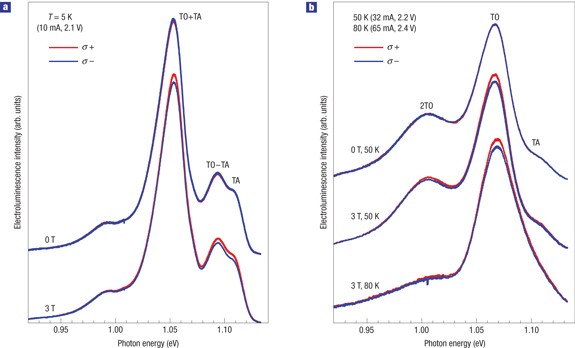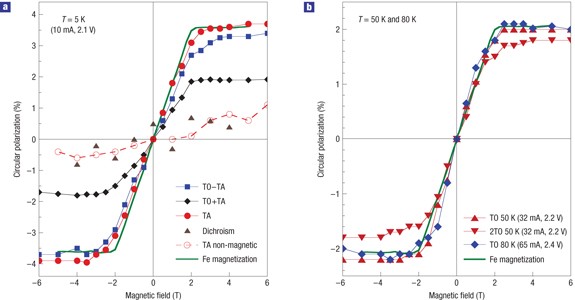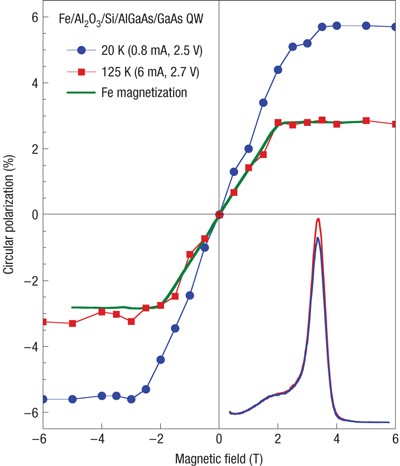Electrical spin-injection into silicon from a ferromagnetic metal/tunnel barrier contact (original) (raw)
The manipulation of carrier spin angular momentum in semiconductors offers enhanced functionality and a new paradigm for device operation2,3,4. Recent calculations5 indicate that spin-based field-effect transistors can exhibit lower leakage currents and switching energies than those projected for end-of-roadmap complementary metal–oxide–semiconductor devices, significantly reducing heat dissipation, which has been identified as one of the grand challenges facing scaled complementary metal–oxide–semiconductors[1](/articles/nphys673#ref-CR1 "International Technology Roadmap for Semiconductors, 2005 Edition, http://www.itrs.net/reports.html
. See Executive Summary and Emerging Research Devices."). Several fundamental properties of Si make it an ideal host for spin-based functionality. Spin–orbit effects producing spin relaxation are much smaller in Si than in GaAs owing to the lower atomic mass and the inversion symmetry of the crystal structure itself. The dominant naturally occurring isotope, Si28, has no nuclear spin, suppressing hyperfine interactions. Consequently, spin lifetimes are expected to be relatively long, as demonstrated by electron paramagnetic resonance work on donor-bound electrons[6](/articles/nphys673#ref-CR6 "Feher, G. & Gere, E. A. Electron spin resonance experiments on donors in silicon: II. Electron spin relaxation effects. Phys. Rev. 114, 1245–1256 (1959).") and more recent work on free electrons in Si (refs [7](/articles/nphys673#ref-CR7 "Tyryshkin, A. M., Lyon, S. A., Jantsch, W. & Schaffler, F. A. Spin manipulation of free two-dimensional electrons in Si/SiGe quantum wells. Phys. Rev. Lett. 94, 126802 (2005)."),[8](/articles/nphys673#ref-CR8 "Zarifis, V. & Castner, T. G. ESR linewidth behavior for barely metallic n-type silicon. Phys. Rev. B 36, 6198–6201 (1987).")). In addition, silicon’s mature technology base and overwhelming dominance of the semiconductor industry make it an obvious choice for implementing spin-based functionality. Several spin-based Si devices have indeed been proposed, including transistor structures[9](/articles/nphys673#ref-CR9 "Sugahara, S. & Tanaka, M. A spin metal-oxide-semiconductor field effect transistor using half-metallic contacts for the source and drain. Appl. Phys. Lett. 84, 2307–2309 (2004)."),[10](/articles/nphys673#ref-CR10 "Dennis, C. L., Tiusan, C. V., Gregg, J. F., Ensell, G. J. & Thompson, S. M. Silicon spin diffusion transistor: Materials, physics and device characteristics. IEE Proc. Circuits Dev. Syst. 152, 340–354 (2005).") and elements for application in quantum computation/information technology[11](/articles/nphys673#ref-CR11 "Yablonovitch, E. et al. Quantum repeaters based on Si/SiGe heterostructures. Proc. IEEE 91, 761–780 (2003).").Despite these advantages, efficient electrical spin injection and transport in Si have yet to be demonstrated. Here, we electrically inject spin-polarized electrons from a thin ferromagnetic Fe film through an Al2O3 tunnel barrier into a Si(001) n–i–p doped heterostructure, and observe circular polarization of the electroluminescence. This indicates that the electrons retain a net spin polarization, which we estimate to be ∼30%, before radiative recombination with unpolarized holes in the Si, and transfer their spin momentum to the optical field as required by momentum conservation, enabling detection and analysis. This interpretation is confirmed by similar measurements on Fe/Al2O3/Si/AlGaAs/GaAs quantum-well structures in which the spin-polarized electrons drift under applied field from the Si and recombine in the GaAs quantum well, where the polarized electroluminescence can be quantitatively analysed12, yielding an electron spin polarization of 10%.
Two types of sample were studied and are shown in Fig. 1 with a band diagram of the contact region. First, Si and Si/SiGe samples consisting of n–i–p doped heterostructures were grown by molecular beam epitaxy (MBE) on p-doped Si(001) wafers (see the Methods section). Second, Si epilayers (n-doped, 80 nm thick) were grown on n-Al0.1Ga0.9As/GaAs/p-Al0.3Ga0.7As quantum-well structures, which were grown in turn on p-GaAs(001) substrates in a stand-alone MBE chamber. Although the crystalline quality of the Si is lower and a further heterointerface is introduced (Si/Al0.1Ga0.9As), these samples enable a quantitative determination of the electron spin polarization of the electrons that radiatively recombine in the GaAs through standard analysis using quantum selection rules12.
Figure 1: Cross-sections of samples and band diagram of the contact region.
a,b, When electrons are injected from the Fe contact under electrical bias, radiative recombination is observed as the electrons recombine with unpolarized holes in either the Si (Si n–i–p structure) (a) or the GaAs quantum well (Si/AlGaAs/GaAs/AlGaAs structure) (b). c, Band diagram showing the exchange split bands of the Fe contact, with majority spin electron states highlighted in red (up arrow) and minority spin states highlighted in blue (down arrow). d, Photograph of processed LED structures. The light circular mesas are the active light-emitting areas, the contact metallization appears in yellow and the wire bond contacts appear to the right.
The Fe/Al2O3 contacts were deposited in a separate MBE system (see the Methods section)13. A tunnel barrier provides a readily implemented post-growth contact that alleviates the large mismatch in conductivity between the metal and semiconductor that would otherwise preclude spin injection14,15. Similar Fe/Al2O3 contacts were deposited directly on n-Si(001) wafers to provide reference samples for analysis of the transport process using procedures described previously on the basis of the Rowell criteria13,16. These measurements confirmed that transport at low temperatures occurred by tunnelling.
Arrays of surface-emitting light-emitting diodes (LEDs) with active areas 200–400 μm in diameter were fabricated4 (Fig. 1d), and individual diodes biased to inject electrons from the Fe into the Si and Si/AlGaAs/GaAs/AlGaAs n–i–p structures. The resultant electroluminescence emitted along the surface normal was measured in the Faraday geometry, and spectroscopically analysed with a 0.5 m spectrometer and a cooled InGaAs array detector. The circular polarization was determined using a rotatable quarter-wave plate and fixed linear polarizer that preceded the spectrometer, and is expressed as _P_circ=(I+−_I_−)/(I++_I_−), where _I_± is the intensity of the electroluminescence analysed as positive (σ+) or negative (_σ_−) circularly polarized.
Typical electroluminescence spectra from an Fe/Al2O3/Si n–i–p structure are shown in Fig. 2 for _T_=5–80 K, analysed for _σ_+ and _σ_− circular polarization. Emission was initially observed at a bias of 1.6 V and 1 mA, but higher biases were typically used to reduce the data acquisition time. At 5 K, the spectra are dominated by three features arising from electron–hole recombination accompanied by transverse acoustic (TA) or transverse optical (TO) phonon emission in the p+ Si layer, which is 140 nm below the Fe contact. These are identified as TA (1,105 meV), TO–TA (1,090 meV) and TO+TA (1,050 meV) associated with the B acceptor, following the assignments of ref. 17. These TA-related features are suppressed at higher temperatures (Fig. 2b), where the TO feature (1,070 meV) dominates at 50 and 80 K. The electroluminescence becomes too weak at higher temperatures for reliable analysis.
Figure 2: Electroluminescence spectra from a Si n–i–p structure with an Fe/Al2O3 contact.
a,b, Spectra at zero field and 3 T, analysed for _σ_+ (red) and _σ_− (blue) circular polarization, for _T_=5 K (a) and _T_=50 and 80 K (b). The _σ_+ and _σ_− traces are coincident at zero field, whereas net polarization is clearly observed at 3 T up to 80 K. The magnetic field is applied along the surface normal (direction of light propagation).
At zero field, no circular polarization is observed because the Fe magnetization and corresponding electron spin orientation lie in-plane and orthogonal to the light propagation direction. Although spin injection may occur, it cannot be detected with this orthogonal alignment. Thus, a magnetic field is applied to rotate the Fe spin orientation out-of-plane, and the main spectral features each exhibit circular polarization, as shown by the difference between the red (σ+) and blue (_σ_−) curves in the 3 T spectra at _T_=5, 50 and 80 K.
The magnetic-field dependence of _P_circ for each feature is summarized in Fig. 3. As the Fe magnetization (and majority electron spin orientation) rotates out-of-plane with increasing field, _P_circ increases and saturates above ∼2.5 T with average values of 3.7%, 3.5% and 1.9% for the TA, TO–TA and TO+TA features, respectively, at 5 K, 2.1% and 1.8% for the TO and 2TO features at 50 K, and 2% for the TO at 80 K. Note that for each feature, _P_circ tracks the magnetization of the Fe contact, shown as a solid line scaled to the data, indicating that the spin orientation of the electrons that radiatively recombine in the Si directly reflects that of the electron spin orientation in the Fe contact. The field at which the Fe magnetization saturates out-of-plane is characteristic of Fe (_H_sat=4π_M_Fe=2.2 T), and is unaffected by lateral patterning that would alter the in-plane coercive field. This is also evidence against possible compound formation (for example, FeSi) at the interface owing to pinholes, which would lead to a different field dependence. The monotonic decrease in _P_circ from the higher energy (TA) to the lowest energy feature (TO+TA) as seen in Fig. 3a is consistent with spin relaxation expected to accompany electron energy relaxation. Similar results were obtained from several samples from different Si MBE growth processes, including samples that incorporated three (3 nm Si0.7Ge0.3/12 nm Si) quantum wells in the i-Si layer.
Figure 3: Magnetic-field dependence of _P_circ for the features in the electroluminescence spectra of Fig. 2 from the Fe/Al2O3/Si n–i–p structure.
a, _T_=5 K. b, _T_=50 and 80 K. _P_circ for each feature tracks the magnetization and majority electron spin orientation of the Fe film, shown as the solid line. In a, the dashed line shows the circular polarization from the reference sample with the non-magnetic contact (In/Al2O3, open circles), whereas the triangles show the contribution from circular dichroism due to transmission of the electroluminescence through the Fe film. _P_circ shows little bias dependence over the range (1 mA, 1.6 V) to (50 mA, 3.0 V), and the current through the device does not change with magnetic field. A weak paramagnetic background of 0.1% T−1 was subtracted. The error bars are typically ±0.5%.
Data for an identical sample with a non-magnetic metal tunnel contact (In/Al2O3, open circles Fig. 3a) show only a weak paramagnetic response of ∼0.1% T−1, demonstrating that _P_circ observed from the Fe contact LEDs is not due to field-induced effects in the Si. Similarly, the circular dichroism due to transmission of the light through the Fe film was both calculated and measured with photoluminescence4 on an undoped reference sample with an Fe/Al2O3 contact (triangles, Fig. 3a), and is smaller (±0.5%) than the _P_circ observed in the electroluminescence from the Fe contact samples. These data together unambiguously demonstrate that spin-polarized electrons are electrically injected from the Fe contact into the Si heterostructure.
The sign of _P_circ indicates that the electron spin polarization in the Si reflects the majority spin orientation in the Fe contact. This is similar to previous results obtained for spin injection from Fe into GaAs (ref. 4), using either Schottky16,18, MgO (ref. 19) or Al2O3 (refs 13,20) tunnel barrier contacts.
The magnitude of _P_circ from Si is smaller than that typically observed for spin injection from Fe into GaAs(001) quantum wells13,16,18,19,20, although it exceeds some of the earlier reports for GaAs (refs 21,22). This is due in part to the partitioning of the electron spin angular momentum between the photon and phonon for phonon-assisted radiative recombination that typically dominates in indirect-gap materials. As the electron spin angular momentum must be shared by the photons and any phonons involved in radiative recombination, the photons will carry away only a fraction of the spin angular momentum of the initial spin-polarized electron population. Previous work on Fe/GaAs spin LED samples has shown that features in the electroluminescence spectrum associated with phonon emission exhibit much lower _P_circ than the excitonic (no-phonon) feature23. Thus, in contrast with GaAs quantum wells where the electron spin polarization is effectively transferred to the optical polarization, our experimentally measured value of _P_circ(Si) will result in a significant underestimation of the corresponding electron polarization. The optical selection rules commonly used to quantitatively relate optical and electron spin polarization in GaAs (ref. 12) cannot be applied in Si to obtain a numerical value. Consequently, we base our interpretation of polarized electroluminescence from Si on the broader rule of conservation of momentum to estimate the electron spin polarization in the following paragraph. Although the band structure and indirect gap of Si complicate the application of polarized optical spectroscopic techniques that are routinely used in GaAs, it is interesting to note that the first successful optical pumping experiments to induce a net electron/nuclear spin polarization were carried out in Si rather than in a direct-gap material by Lampel24.
A second significant factor affecting _P_circ is the very long radiative lifetime typical of indirect-gap materials—the electron spin polarization decays exponentially with a characteristic time, _τ_s, before radiative recombination occurs. For conduction-band electrons contributing to transport, the relevant parameter is the spin lifetime of free electrons7,8 rather than of donor-bound electrons6. Recent measurements on modulation-doped two-dimensional electron gas structures with n∼2×1011 cm−2 (∼1019 cm−3) obtained _τ_s∼1 μs at 5 K (ref. 7). Previous work on phosphorus-doped bulk Si above the metal–insulator transition also reported _τ_s∼1 μs for n=9×1018 cm−3 at 4 K (ref. 8), and showed that _τ_s decreased with increasing electron concentration. Our samples are doped n∼2×1018 cm−3, and thus _τ_s is expected to be longer, of the order of 10 μs. Typical values for the radiative lifetime, _τ_r, in doped Si are 0.1–1 ms (refs 25,26). The radiative lifetime of emission features associated specifically with acoustic phonon emission was measured to be 480 μs for 1 K<T<5 K (ref. 25). Using a rate-equation model to account for the effect of these lifetimes, an order-of-magnitude estimate of the electron spin polarization achieved in the silicon is given by12 _P_Si=_P_circ(1+_τ_r/_τ_s)∼0.03(1+0.1/0.01)∼0.3 or 30%.
Support for this estimate is provided by similar experiments on Fe/Al2O3/80 nm n-Si/80 nm n-Al0.1Ga0.9As/10 nm GaAs quantum well/200 nm p-Al0.3Ga0.7As heterostructures (Fig. 1b), in which electrons injected from the Fe into the Si drift across the Si/Al0.1Ga0.9As interface with applied bias and radiatively recombine in the GaAs quantum well. In this case, the standard quantum selection rules can be rigorously applied to quantify the electron spin polarization in the GaAs (refs 12,27). The electroluminescence spectrum at 20 K and 3 T is shown in the inset of Fig. 4, and is dominated by the free-exciton emission from the GaAs quantum well at 1.54 eV. The field dependence of the polarization of the GaAs free exciton, _P_circ(GaAs), is shown in Fig. 4. _P_circ(GaAs) again tracks the magnetization of the Fe contact, as discussed for the data in Fig. 3, and saturates at values of 5.6% at 20 K and 2.8% at 125 K. Separate optical pumping measurements12 on the GaAs quantum well provide a direct measure of _τ_r/_τ_s (GaAs quantum well)=0.8. Thus, the spin polarization of the electrons in the GaAs is P G a A _s_=_P_circ(1+_τ_r/_τ_s)=0.1 or 10% at 20 K. This is consistent with our estimate above of _P_Si∼30%, and establishes a firm lower bound for _P_Si>10%. It is indeed remarkable that the electrons injected from the Fe contact drift through the Si, cross the Si/AlGaAs interface and still retain a significant spin polarization, given (1) the relatively poor crystalline quality of Si epilayers on GaAs (lattice mismatch 3.9%), (2) the heterovalent interface structure, (3) the 0.3 eV conduction-band offset (Si band lower than Al0.1Ga0.9As) (ref. 28) and (4) the fact that the sample surface was exposed to air before growth of the Si, and then again before growth of the Fe/Al2O3 contact.
Figure 4: Magnetic-field dependence of _P_circ for the GaAs quantum-well free exciton in the electroluminescence spectra from the Fe/Al2O3/Si/AlGaAs/GaAs quantum well/AlGaAs n–i–p structure.
_P_circ tracks the magnetization and majority electron spin orientation of the Fe film, shown as the solid line. The electroluminescence spectrum at 3 T and 20 K is shown in the inset, analysed for _σ_+ (red) and _σ_− (blue) polarization. The main peak is the free exciton at 1.54 eV from the 10 nm GaAs quantum well.
Note added in review. Recently published work used a spin-valve transistor structure to inject hot electrons (800 meV, determined by the Schottky barrier) into silicon, in which 1 mA of input current was required to generate 1 nA of spin-polarized current of unstated polarization in the silicon29. In contrast, the approach described here injects spin-polarized electrons near the Si conduction-band edge with near-unity conversion efficiency, where the electron energy is determined by the bias applied across the tunnel barrier (∼10–100 meV). The realization of efficient electrical injection and significant spin polarization using a simple tunnel barrier compatible with ‘back-end’ Si processing should greatly facilitate progress in the development of Si-based spintronic devices.



